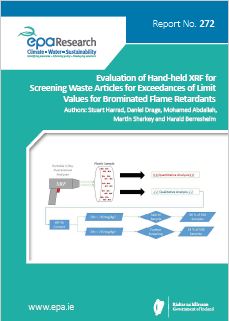Research 272: Evaluation of Hand-held XRF for Screening Waste Articles for Exceedances of Limit Values for Brominated Flame Retardants.
Authors: Stuart Harrad, Daniel Drage, Mohamed Abdallah, Martin Sharkey and Harald Berresheim
Summary: Recent research has demonstrated the presence of restricted persistent organic pollutant (POP) brominated flame retardants (BFRs) in items such as children’s toys and food contact articles. As the presence of these contaminants in such items serves no useful purpose, they are thought to originate from the use of recycled plastics that were originally treated with BFRs.

Identifying Pressures
Recent research has demonstrated the presence of restricted persistent organic pollutant brominated flame retardants (POPBFRs) in items such as children’s toys and food contact articles. As the presence of these contaminants in such items serves no useful purpose, they are thought to originate from the use of recycled plastics originally treated with POP-BFRs. To address this issue, European Union (EU) Regulation 850/2004 inter alia specifies low POP concentration limits (LPCLs) such that articles exceeding the LPCL (1000 mg/kg) cannot be recycled and must be treated so that their POP-BFR content is destroyed. Given the very substantial use of POP-BFRs in applications such as electrical and electronic goods, polystyrene building insulation foam, and seating foam and fabrics in homes, offices and cars, monitoring compliance with LPCLs represents a substantial undertaking, compounded by conventional laboratory methods for measuring POP-BFRs being destructive, time-consuming, expensive, and incompatible with being conducted in situ at waste handling sites. This research thus evaluated the feasibility of using hand-held X-ray fluorescence (XRF) spectrometers to measure bromine in waste articles as a surrogate.
Informing Policy
Data from this project demonstrated that removal of articles exceeding LPCLs would remove 98% of the 33 tonnes/year of POP-BFRs currently generated in Ireland within the plastic recycling stream. To evaluate hand-held XRF as a low-cost, user-friendly tool for monitoring compliance with LPCLs, XRF was used to measure total bromine in 538 samples from various waste categories. These data were compared with POP-BFR concentrations for the same samples. Although XRF correctly identified all articles exceeding LPCLs, it incorrectly indicated that 6.3% of articles exceeded the LPCLs. This was because of the presence of BFRs, for which LPCLs do not currently exist as they are not restricted. Such “false exceedances” result in a small proportion of articles being incorrectly diverted from recycling, with unnecessary economic costs when such articles are subjected to special treatment to destroy their POP-BFR content, most probably by incineration. Balanced against this, as false exceedances are caused by BFRs that, although not presently restricted, may be so in the future, and whose presence in the recycling stream cannot be considered desirable, they are deemed an acceptable limitation of the use of XRF.
Developing Solutions
Although the cost- and time-effectiveness of hand-held XRF relative to conventional methods for measuring POPBFRs renders the former potentially feasible for large-scale monitoring of LPCL compliance, use of hand-held XRF to screen individual waste articles may still be considered overly time-consuming by waste treatment professionals. Consequently, automation of the screening process using a “fixed/bench-top” XRF instrument in conjunction with a conveyor belt carrying waste articles is considered a feasible approach for large-scale waste handling operations, albeit one requiring greater capital outlay. In the shorter term, approaches to minimise the number of articles requiring checking for compliance with LPCLs merit consideration. These involve using data from this project that show very low BFR concentrations and no exceedances of current or anticipated LPCLs for some waste categories such as extruded polystyrene (XPS) building insulation foam. On-site separation of XPS from expanded polystyrene (EPS) foam (for which 35% of samples were found to exceed the LPCL) to allow recycling or reuse of XPS without checking for LPCL compliance would reduce the monitoring burden placed on the waste management industry.
https://www.epa.ie/media/epa-2020/publications/research/Research_272_Thumbnail[1].jpg